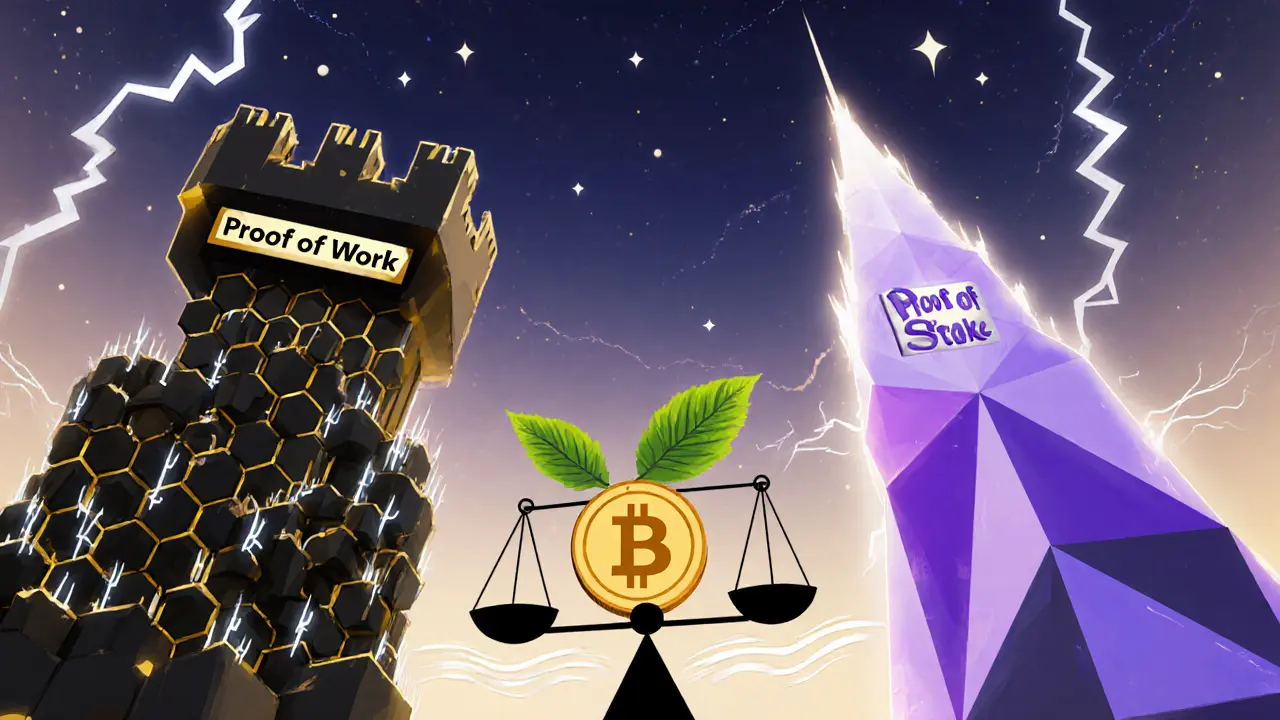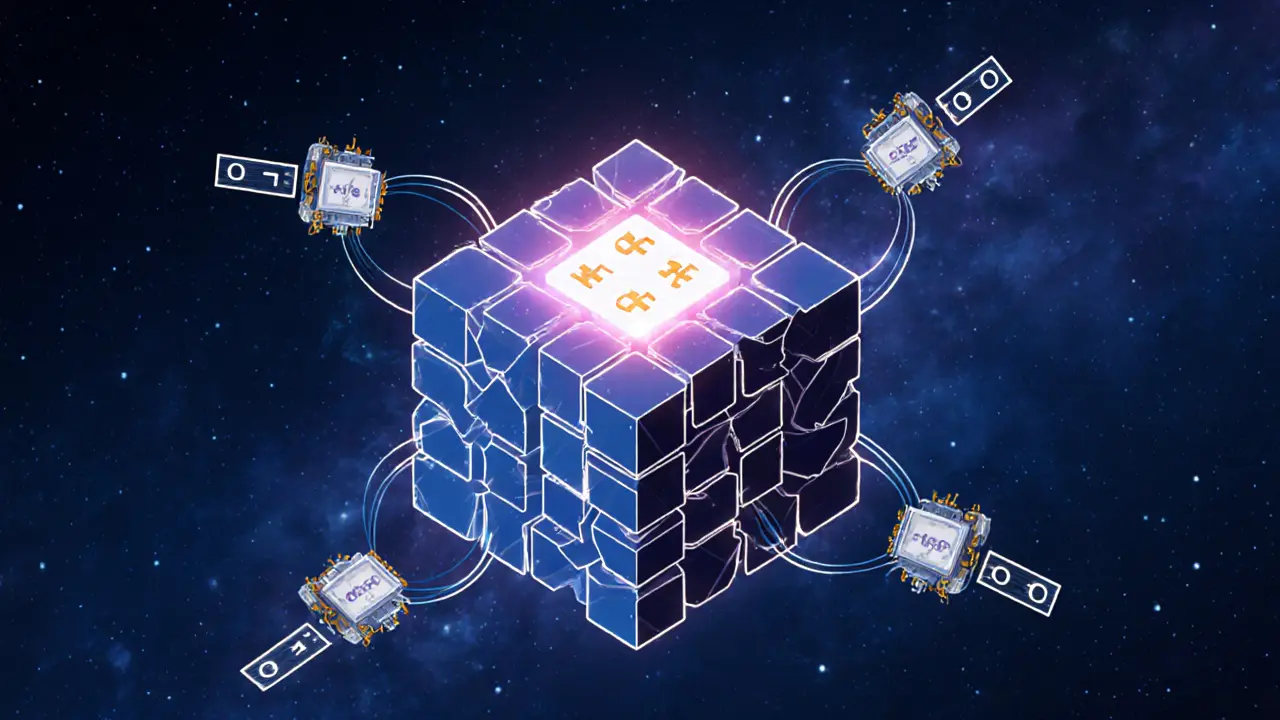Bitcoin Mining Profitability Calculator
Mining Inputs
Results
Note: This calculator uses Bitcoin's current block reward of 3.125 BTC (post-2024 halving) and average block time of 10 minutes. Energy costs are based on 3,250 watts (Antminer S19 Pro).
Imagine a digital money system where no bank, government, or company controls the ledger. No one to stop double-spending, no middleman to verify transactions. How do you know someone didn’t just send the same Bitcoin to two people at once? That’s the problem proof of work solves. It’s the original engine behind Bitcoin and still runs major blockchains today. It’s not magic. It’s math, electricity, and competition.
How Proof of Work Actually Works
Proof of work (PoW) is a system where computers, called miners, compete to solve a hard math puzzle. The first one to solve it gets to add the next block of transactions to the blockchain and earns a reward. The puzzle isn’t about finding the right answer-it’s about finding a specific number that, when combined with the block data and run through a hash function, produces an output that starts with a certain number of zeros.
Bitcoin uses the SHA-256 algorithm. Miners take the block’s transaction data, a reference to the previous block, and a random number called a nonce. They mash it all together and hash it. If the result doesn’t meet the target (like starting with 18 zeros), they change the nonce and try again. Billions of times per second. It’s like rolling dice until you get a specific combination. Easy to check if you got it right. Nearly impossible to guess without trying every option.
The network adjusts how hard the puzzle is every two weeks. If miners are solving blocks too fast, the difficulty goes up. If they’re too slow, it goes down. The goal? One block every 10 minutes. That’s the heartbeat of Bitcoin.
Why Proof of Work Is Secure
Security in PoW comes from cost. To cheat, you’d need to control more than half the network’s total computing power-a 51% attack. That means buying and running enough ASIC miners to outpace every other miner on Earth. According to experts, that would cost hundreds of billions of dollars in hardware and electricity. Even if you could afford it, the moment you tried to reverse transactions, the market would crash. Your own investment would be worthless.
Bitcoin’s network has never been successfully attacked in over 15 years. Its hash rate-the total computing power-hit 600 exahashes per second in early 2024. That’s 600 quintillion guesses per second. No other system in history has maintained that level of security without a central authority.
That’s why Bitcoin is called “digital gold.” It’s not fast. It’s not cheap. But it’s the most trusted store of value on the internet because of proof of work.
Who Mines and What It Costs
Early Bitcoin mining was done on regular laptops. Now, it’s all about ASICs-specialized chips built for one thing: hashing. The Bitmain Antminer S19 Pro, for example, can do 110 trillion hashes per second. But it also uses 3,250 watts of power-enough to run a small space heater nonstop.
Electricity is the biggest cost. In places like Texas or Kazakhstan, where power is cheap, mining farms sprawl across warehouses. In Europe or New York, where energy is expensive and regulated, it’s nearly impossible to compete. A serious mining operation needs at least 50 ASIC machines, a dedicated 50 Mbps internet line, industrial cooling, and $50,000 upfront. And that’s just to break even.
Miners don’t just get paid in new Bitcoin. They also collect transaction fees. Right now, the block reward is 6.25 BTC, but that cuts in half every four years. The next halving is in April 2024, dropping it to 3.125 BTC. Eventually, fees will be the only incentive. That’s why miners are already optimizing for high-fee transactions.

Proof of Work vs. Proof of Stake
Ethereum switched from proof of work to proof of stake in September 2022. That was a big deal. PoS doesn’t use miners. Instead, validators lock up (stake) ETH as collateral to propose and vote on blocks. If they act dishonestly, they lose their stake. It’s less energy-intensive-Ethereum cut its power use by 99.95%.
Here’s how they compare:
| Feature | Proof of Work (PoW) | Proof of Stake (PoS) |
|---|---|---|
| Energy Use | Extremely high (Bitcoin uses ~121 TWh/year) | Very low (Ethereum uses ~0.01 TWh/year) |
| Security Model | Cost-based (attack = billions in hardware) | Slashing (lose stake if dishonest) |
| Speed | 4-7 transactions per second | 15-30 transactions per second |
| Hardware Required | ASIC miners | Standard computer |
| Decentralization Risk | Centralized mining pools | Wealth concentration among stakers |
| Used By | Bitcoin, Litecoin, Monero, Ethereum Classic | Ethereum, Solana, Cardano |
PoW is slower and thirstier, but its security has been battle-tested for over a decade. PoS is faster and greener, but it’s still young. No PoS chain has ever survived a major market crash or coordinated attack. That’s why Bitcoiners stick with PoW. They trust the math more than the economics.
Environmental Impact and the Push for Change
Bitcoin uses more electricity than Argentina. That’s not a myth-it’s from the Cambridge Bitcoin Electricity Consumption Index. Critics call it unsustainable. Supporters say it’s just inefficient energy being put to use.
Many Bitcoin miners now use stranded or wasted energy-flared gas from oil fields, hydro surplus in Canada, or solar power in Texas. Marathon Digital Holdings says 68.5% of its mining is powered by renewables. Some miners even use waste heat to warm greenhouses or buildings.
But regulation is catching up. The European Union’s MiCA law, effective June 2024, requires PoW networks to report their carbon footprint. New York banned new mining operations using fossil fuels. China outlawed mining in 2021, forcing half the network offline overnight. Bitcoin kept going.
The real question isn’t whether PoW is green. It’s whether society values security more than speed. For digital cash that’s meant to last 100 years, the answer is still yes-for now.

Where Proof of Work Stands Today
As of 2025, PoW still powers 58.7% of the total cryptocurrency market cap-mostly because of Bitcoin’s $578 billion value. But new blockchains? Almost none use it. Over 95% of enterprise blockchain projects avoid PoW due to ESG concerns.
Bitcoin’s core team isn’t trying to fix PoW. They’re improving it quietly. The Taproot upgrade in 2021 made transactions more private and efficient without changing the consensus. No one is building a better PoW. They’re building alternatives.
Still, Bitcoin’s network has never gone down. Its uptime is 99.98% since 2009. No bank, no cloud provider, no government system can say that.
Proof of work isn’t perfect. But it’s the only system that let a decentralized network of strangers agree on truth without trusting anyone. That’s why it still matters.
What Comes Next?
Will PoW disappear? No. Bitcoin won’t switch. It’s too fundamental. But it will shrink as a percentage of the crypto world. Ethereum, Solana, and others will keep growing with PoS. PoW will remain the fortress protecting digital gold.
Some researchers are exploring “Proof of Useful Work”-where mining computations also solve scientific problems like protein folding or climate modeling. But those are still lab experiments. No one’s running them at scale.
For now, proof of work lives on because it works. It’s slow. It’s loud. It’s expensive. But it’s the most secure digital ledger ever built. And until something better comes along, it’ll keep running.

Kevin Johnston
October 30, 2025 AT 09:36Dr. Monica Ellis-Blied
October 31, 2025 AT 17:15Herbert Ruiz
November 1, 2025 AT 21:16Saurav Deshpande
November 2, 2025 AT 00:31Paul Lyman
November 4, 2025 AT 00:09Frech Patz
November 5, 2025 AT 10:23Derajanique Mckinney
November 5, 2025 AT 18:23Rosanna Gulisano
November 6, 2025 AT 04:28Sheetal Tolambe
November 7, 2025 AT 01:45gurmukh bhambra
November 7, 2025 AT 04:41Sunny Kashyap
November 7, 2025 AT 17:20james mason
November 8, 2025 AT 21:22Anna Mitchell
November 9, 2025 AT 09:09Pranav Shimpi
November 9, 2025 AT 21:42jummy santh
November 10, 2025 AT 23:43Kirsten McCallum
November 11, 2025 AT 12:24